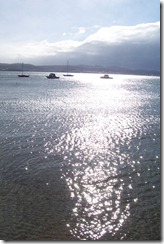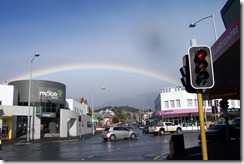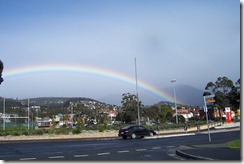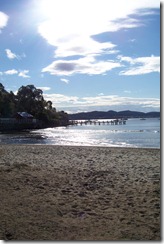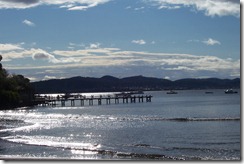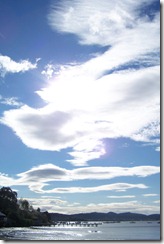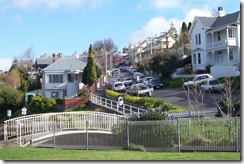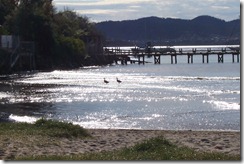Welcome, Im so glad you could join me on my journey to discover photographically the beauty of my surroundings, the many moods of my majestic mountain, Mount Wellington and life that thrives in the foot hills that she governs.
Thursday, September 30, 2010
skype.... the heart beat
For those of us who rely on the skypness of others and your having trouble with your connection, try this link.. http://heartbeat.skype.com/
Wednesday, September 29, 2010
Still another a cold day in Paradise!
Yes another cold day in Hobartian paradise. The snow just keeps on coming but we're not complaining (much). Makes for lovely photos that can be used in blogs. I hope the weather is not a deterrent to anyone who is thinking of visiting my fair isle, come please you are all more than welcome.
 |
| St David's park Hobart |
 |
| A little Hobart history |
 |
| In'spiring' isn't it. |
Tuesday, September 28, 2010
From Monday to chilly Tuesday………
An article that was just published in the Huffington Post
By David Segal and Aaron Swartz
When it really matters to them, Congressmembers can come together -- with a panache and wry wit you didn't know they had. As banned books week gets underway, and President Obama admonishes oppressive regimes for their censorship of the Internet, a group of powerful Senators -- Republicans and Democrats alike -- have signed onto a bill that would vastly expand the government's power to censor the Internet.
The Combating Online Infringement and Counterfeits Act (COICA) was introduced just one week ago, but it's greased and ready to move, with a hearing in front of the Judiciary Committee this Thursday. If people don't speak out, US citizens could soon find themselves joining Iranians and Chinese in being blocked from accessing broad chunks of the public Internet.
IF you want to read more about this please click the following link HUFFINGTON POST
When it really matters to them, Congressmembers can come together -- with a panache and wry wit you didn't know they had. As banned books week gets underway, and President Obama admonishes oppressive regimes for their censorship of the Internet, a group of powerful Senators -- Republicans and Democrats alike -- have signed onto a bill that would vastly expand the government's power to censor the Internet.
The Combating Online Infringement and Counterfeits Act (COICA) was introduced just one week ago, but it's greased and ready to move, with a hearing in front of the Judiciary Committee this Thursday. If people don't speak out, US citizens could soon find themselves joining Iranians and Chinese in being blocked from accessing broad chunks of the public Internet.
IF you want to read more about this please click the following link HUFFINGTON POST
Saturday, September 25, 2010
SUNSHINE AND MARIGOLDS……….
Thursday, September 23, 2010
Bright Blue Day
I am reflecting early
Having just submittted my first assignment (for Net 102) Ive broken out in a sweat!
I feel that I have accomplished something today :) 1. my first major submission and 2. not having a nervous breakdown because of it *ahahaha* Now all I have to do is wait and see what mark I get down for it.
I feel that I have accomplished something today :) 1. my first major submission and 2. not having a nervous breakdown because of it *ahahaha* Now all I have to do is wait and see what mark I get down for it.
 |
| Wishing myself and everyone else luck and lots of it! |
Net 102 Topic 1.6 Politics: Julia Gillard is My Facebook friend. Task 1.4 (assignment 1)
Net 102 Week 4 Topic 1.6: Politics: Julia Gillard is My Facebook Friend
TASK 1.4 (ASSIGNMENT 1):
Navigate around and discuss two of the following sites in terms of the kinds of involvement they encourage. Your initial writing for this topic should not be above 500 words, although it is fine for notes and extracts from the discussion, and further reflection, to take you over this limit: The two 'bold' links below are the ones that I will be discussing.
Getup.org: promotes themselves as an independent political movement (activist group) whose main role is to educate Australians on current political issues, greater social responsibility and encourage voting. Staffed by volunteers and a core team of employed staff they are located in Sydney with over 370 000 members (384 061 at time of writing). They conduct research on new political campaigns that interest their members and believe in a shared progressive value system. Their use of media savvy (parody) adverts have attracted national television coverage and repeated plays via the web side YouTube and in the last Federal election (2010) the group ran over 700 television ads.
Their own web site http://www.getup.org.au/ has a link Channel GetUp!A YouTube hosted medium where anyone (current subscribers 1447 at time of writing) can view the majority of their many focus interest and parody clips.
As you navigate around the site you will come across headings such as GetUp! in the News, Take Action! and The latest! which draw the reader's attention.
As GetUp is a volunteer organisation they have no support financially from the current government, instead relying on donations from members and the public to help fund their cause. Membership: Joining is simple and free
Get up encourages community and as such host GetTogethers where members are encouraged to come together in organised gatherings. In navigating to the supplied map I was disappointed to find that there are no groups in Tasmania but that could possibly change in the near future.
After viewing and interacting with GetUp, tonyabbot.com, Tony Abbot's constituent site, Welcome to Warringah, is not as media connected as GetUp, which for a federal member of parliament is quite disappointing. When you first navigate to the site you are greeted with rotating photos of Tony Abbot and his related causes and concerns, if you click on a prominent glow lit photo it will that take you to another web page that hosts subjects like 'Latest press release, Tell us what YOU think' and Tony's eNewsletter (which you can sign up for).
The site does encourage accessibility with RSS, YouTube, Facebook, Twitter and Flickr links. I was interested to learn that Tony Abbot tweeted but from observation the last tweet was 35+ days ago, during the federal election. The Flickr photos are also related to that time period. When I accessed the blog page the last date was Friday 18th of June 2010 which compels me to think that the majority of the site appears to have not been kept up to date with exception to the Press Release section (latest post 14th September 2010).
I would have to say that the site really doesn't encourage me to visit and interact the way GetUp does, it appears quite static and more like an advertisement for Tony Abbot political office, which it is.
Reference
YouTube GetUp election report http://www.youtube.com/watch?v=_mD4P5z1Ssk&feature=player_embedded
(4,157 views at time of writing 23/10/2010)
Tony Abbot http://www.tonyabbott.com.au/
GetUp http://www.getup.org.au/
Wednesday, September 22, 2010
Topic 1.4 Health (submission for discussion board
Author: Tim Holland
Date: Monday, September 20, 2010 5:49:48 PM WST
Subject: Eysenbach reading
Please post any comments on the Eysenbach et al readings here.
Thanks
Tim
Date: Monday, September 20, 2010 5:49:48 PM WST
Subject: Eysenbach reading
Please post any comments on the Eysenbach et al readings here.
Thanks
Tim
I am interested in the privacy aspect of posting personal medical information on line, Eysenbach broached the subject stating that it was a complex issue, ephemeral as any web based information is permanently archived and as such anyone even future employers could possibly access personal past health problems. I find this disconcerting. I have worked in a health based facility and as such had access to others health records as we were linked to all doctors within the state. Even though there are strict non disclosure agreements that have to be signed upon entering employment, what if this is breached by others? With the increased occurrence of hacking of systems how safe are our health records now. How safe were our health records in the first place. I don't particularly want anyone to be able to view my health data unless it's either my-self or my respective doctor.
Topic 1.5 Faith, discussion board response
Author: Tim Holland
Date: Monday, September 20, 2010 6:07:43 PM WST
Subject: Threat to religious institutions?
One of your discussion topics this week is:
The Internet is a threat to religious institutions. Discuss.
There are lots of aspects to this question but I wonder about a) the number
of competing belief systems available on the Internet and the
possibility that a person could change religions
b) Internet based attacks, condemnations and exposes of particular religions and c) the
proliferation of misinformation about religious belief.
Date: Monday, September 20, 2010 6:07:43 PM WST
Subject: Threat to religious institutions?
One of your discussion topics this week is:
The Internet is a threat to religious institutions. Discuss.
There are lots of aspects to this question but I wonder about a) the number
of competing belief systems available on the Internet and the
possibility that a person could change religions
b) Internet based attacks, condemnations and exposes of particular religions and c) the
proliferation of misinformation about religious belief.
The Internet is a threat to religious institutions?I doubt that the internet could be a threat to religious institutions for a couple of reasons. People will ultimately decide for themselves what they believe in and where they will practice. Some could and probably do use the internet to engage and connect with others of ilk belief structure if they have no support or "real life" institution near. If religion is going to flourish within the 21st century then it needs to adapt and keep pace with ways of communicating their chosen message to the masses. Of course there are always those who react strongly and negatively to other religions and utilise the openness of the world wide web to promote their own distaste but again from a readers perspective people will decide for themselves what they believe in and what they read on the web and closing a browser is only one click away.
Tuesday, September 21, 2010
Angles of Hobart
 |
| Angles and boxes, this century and that. Amazing what pictures you can take out of the window of a car. |
Net 102 WEEK 4 Topic 1.5: Faith and Spirituality Online Task 1.4 (Assignment)
Net 102 WEEK 4 Topic 1.5: Faith and Spirituality Online
TASK 1.4 (ASSIGNMENT 1):
How has the internet been used to resist or counteract religious persecution and human rights abuse? As a start, navigate to the Falun Dafa Information Centre (you may use other examples). Less than 500 words.
TASK 1.4 (ASSIGNMENT 1):
How has the internet been used to resist or counteract religious persecution and human rights abuse? As a start, navigate to the Falun Dafa Information Centre (you may use other examples). Less than 500 words.
Faith
–noun
1. Confidence or trust in a person or thing: faith in another's ability.
2. Belief that is not based on proof: He had faith that the hypothesis would be substantiated by fact.
3. Belief in god or in the doctrines or teachings of religion: the firm faith of the Pilgrims.
4. Belief in anything, as a code of ethics, standards of merit, etc.: to be of the same faith with someone concerning honesty.
5. A system of religious belief: the Christian faith; the Jewish faith.
To believe so strongly in those words means that an individual or a group can be singled out, exploited, beaten or have their basic human rights violated and take away from them by a government body who declares that it’s their governing policy and only theirs that should be followed. Religious and belief persecution has been noted in the history books of the world since humans could write e.g. the Spanish inquisition, religious persecution during the English reformation, witch hunts in 18th century North America, Judaism in Germany during World War 2. What they did not have and what we have today is the World Wide Web.
I utilised the link Falun Dafa Information Centre that was supplied by Curtin University Course Net 102 and was taken to the ‘official source on Falun Gong and the Human Rights Crisis in China’. (Over the past two decades I have heard a great deal about the human rights issues within China and other countries via other media e.g. television, news papers and radio broadcasts.) Falun Gong is a belief system that as an individual I have not heard about before now (Falun Gong utilises Qi Gong and recognises a charismatic living leader (1)). A report attached to the site “Why doesn’t Falun Gong feature in the news more often?” clarified this lack of information for me in that there is hardly any information leaving China particularly in regard to suppression of individuals and groups human rights. The Chinese government has gone to great lengths within its own country to dam the leaks by any means necessary, especially in regard to Falun Gong. What is interesting here is that Falun Gong appears to be fully “wired” to the internet and is still able to bring its message to the world via the web.(2).
So how is the internet used to counteract religious persecution and human rights abuse? Quite possibly by having a group of individuals sympathetic to a particular cause live in a country such as North America, whose constitutional right ‘freedom of speech’ enables them to draw attention to and highlight atrocities within a particular country via the medium of a web page, in such media to the masses.
Reference
Falun Dafa Information Centre http://www.faluninfo.net/
On line dictionary http://dictionary.reference.com/browse/faith
Faluninfo.net/article :Why doesn’t Falun Gong feature in the news more often? http://faluninfo.net/article/912/
Falun Gong and the Internet http://www.ojr.org/ojr/ethics/1017964337.php
(1) “Its founder, Li Hongzi, was probably born in 1951 (the question of his precise birth date has been the source of controversy) and established his peculiar brand of Qi Gong in 1992, after having left the semi-official Federation. In 1998, Li moved permanently to New York City, from where he oversees the expansion of Falun Gong internationally. Small groups exist in the main metropolitan areas of the U.S. and Canada, and in some thirty other countries”. (Introvigne, 2010) http://www.cesnur.org/testi/falung101.htm
(2)“The group's secretive leader, Li Hongzhi, lives in New York and directs his movement from abroad with Internet, fax, and telephone. The group is thoroughly wired, with Falun Gong Web sites all over the world, including Asia, the USA, UK, Canada, Israel, and Australia.” (O'Leary, 2000) http://www.ojr.org/ojr/ethics/1017964337.php
Net 102 Week 4 Topic 1.5 Faith and Spirituality Online.
Reading Review
van der Laan, J.M (2009). How the Internet Shapes Religious Life, or the Medium Is Itself the Message. Bulletin of Science, Technology & Society, 29(4), 272 -277. doi:10.1177/0270467609336309.
Skim through most of this article--what we are most interested in is van der Laan's main concerns about the impact of the internet upon religion: what, according to van der Laan, is the problem with the increasing reliance of religious institutions on the internet? Do you agree with his views?
Skim through most of this article--what we are most interested in is van der Laan's main concerns about the impact of the internet upon religion: what, according to van der Laan, is the problem with the increasing reliance of religious institutions on the internet? Do you agree with his views?
Review:
van der Laan begins with a suspicion that over a period of time internet resources have crept into the readings that he was listening to at church. van der Laan discusses in this article how religions, mainly American Protestant Christianity, are becoming more reliant on the internet for information for their sermons. It is poignant to observe during the reading of the article a similarity to supermarket style marketing and checkout delivery of pre-written items for either a single cost or membership enrolments. Also noticing that with the expanding use of internet gathered information “enterprises redirect the interests of the churches to advertising and material success.” (van der Laan, p 274), thus the church becomes money orientated and as such gathering people but instead of delivering a message they use the congregation themselves to deliver financial support in reverse.
van der Laan continues further in the article examining telepresence and how the churches are becoming depersonalised with the installation of satellite technologies. Laans concern is “a more extensive examination of telepresence leads too far away from its focus” and that “suffice to say that presence has long been an essential of primary importance to Christians”, (van der Laan, p 274) but in that with the embodiment of satellite churches, congregations are becoming desensitised van der Laan is cynical in that “the audience needs to be no more engaged with the telepresent pastor than with a television show or movie.” (van der Laan, p 274)
He goes on to express fear that religious life has changed with the advent of the internet and that somehow Christianity has become diluted because the web has become the default source rather than a reference point for all things that are deemed important to religious worship. What may be a fundamental dishonesty is subliminally side stepped with preaching a pre fabricated message from the omnipotent computer.
van der Laan ponders if the internet is god like and that like god the World Wide Web performs miracles, an infinite amount of information at your beck and call, van der Laan suggests that “in a sense it is omniscient, omnipotent and omnipresent.” 21st century Christians have embraced technology and with such the church has had to embrace technology along with them.
My thoughts
Marketing, money, pre-packaged generic sermons as pre discussed, all seem to mesh together within this topic, van der Laan uses the word “insipid” to describe the involvement between all of them and from what he has written his cynicism is heavily peppered throughout the article. In this case is the internet the new “word”? Does the gospel according to the internet become the new message delivered to congregations; I will be interested to read more research on the subject.
Monday, September 20, 2010
Week 3 in review
Week 3: In review Net 102 and Web 101
Having just completed unit 1.4 for Net 102 and entered a new module for Web 101 it has been a phenomenally engrossing week.
I still need to finish one of the reading reviews for Net 102 - The Mundane realities of the everyday lay use of the internet for health, and their consequences for media convergence. I'm not sure if I am going to use this subject for my submitted assignment but I will endeavour to read the article anyway as it has started off quite interesting.
Entering Week 4, I am ahead in Web 101 which gives me a little breathing space to catch up with the readings for Net 102, I have two more topics this week, Faith and Politics, and have just realised that I have to submit my task portfolio by Friday this week! Also at the end of this week I need to submit my first assignment for Web 101: Short Questions and Answers but I am quite confident I will be able to send that in around mid week as I have done all the foundation study. So much to do!
Net 102 Week 3 Topic 1.4 Health: What my doctor didn’t tell me TASK 1.4 (assignment 1)
Net 102 Week 3 Topic 1.4 Health: What my doctor didn't tell me. Task 1.4 (assignment 1)
Select a particular health topic that interests you for any reason (it could be a friend or relative's medical condition, for instance). Find out more about the topic using the Internet. While you are doing this, note down the main ways you'll begin looking and your process of selecting useful sites. How would you say your knowledge of the topic has changed in the course of this research? What are the criteria by which you'd select sites? Finally, briefly describe 2-3 of the most useful sites and Internet applications and the ways in which they'd be useful to people visiting them. Not more than 500 words.
I decided to investigate depression as it is a condition that not only affects my life but that of many others.
I opened an internet browser and typed DEPRESSION in the search box.
There are, according to the Bing search, over 64,900,000 results for that particular subject. I posed a question to myself -where do I start? I need to narrow my search parameters so I chose to look at sites that are Australian and that have links that are localised preferring to keep things a little closer to home.
Main ways of looking: Bing search engine via Windows Internet Explorer
Useful sites including Internet Applications available:
BeyondBlue: http://www.beyondblue.org.au/index.aspx? Australian BeyondBlue is an interesting site. The main page has a great deal of information on various forms of depression, medical information and user interaction (personal accounts). The site has information links such as the telephone Info Line, Find a doctor or other mental health practitioner hyperlink, it even has Find us on Face Book. It is multi lingual and hosts links to their BeyondBlue television ads. Useful, the focus in on aiding localalised depression sufferers.
ABC.net.au Health and Wellbeing: http://www.abc.net.au/health/library/stories/2007/06/05/1944066.htm Australian site, multi-functional. It has an A to Z hyperlinked library for personal research. Information articles on various forms of depression e.g. Mental Health First Aid, Mood gym and Youth beyondblue. It even has a quiz that you can take to see if you or someone you know suffers from depression. The More Info section at the bottom of the page is extremely useful as it contains links to other depression sites. Useful in that it has a library full of information and practical suggestions.
Black Dog Institute: http://www.blackdoginstitute.org.au/ "The Black Dog Institute is a not-for-profit, educational, research, clinical and community-oriented facility offering specialist expertise in depression and bipolar disorder." (Blackdoginstitute 2010) Australian. Contains two sites in one, the public site and also on for health professionals. The site is mainly for men but is an interesting research point. It is interactive but not as much as the Beyondblue one. Blackdog has links to information for getting help as well as a research link. It has a very interesting link to a questionnaire concerning temperament and personality http://www.blackdoginstitute.org.au/surveys/Temperament/index.html
Useful, it is a site that has been set up for mainly men suffering depression but contains relevant information to both male and female readers. Their research is directed as such.
My knowledge change: Having endured depression since my formative teenage years I have had extensive experience with the subject. The majority of information that I have had access to in the past has been via the medical practitioner and research done with books. Looking through the sites that are based in Australia has been very interesting. I have been able to access support group information concerning my particular type of depression, is localised to my area and because I am researching on the Web it has given me a degree of anonymity that walking in to a doctor's office has not.
Criteria for selecting sites: Australian, location specific, practical and easy to navigate around.
Net 102 Week 3 Topic 1.4 Health: What my doctor didn’t tell me Reading Review
Net 102 Week 3 Topic 1.4 Health: What my doctor didn't tell me. Reading Review
Gunther Eysenbach. (2008, August 25). Medicine 2.0: Social Networking, Collaboration, Participation, Apomediation, and Openness. Journal of Medical Internet Research. 10(3). (Archived by Web Cite)
This is partly a projection, partly a description of the author's observations regarding the development of 'Medicine 2.0'. What would such trends imply in terms of community, power, economy and identity?Medicine 2.0: Social Networking, Collaboration, Participation, Apomediation, and Openness
This particular article discusses how Web 2.0 is being increasingly utilised by not only medical practitioners but also by the consumer (the people requiring medical advice) to access personal health records via different medical platforms and importantly combined with social networking sites has created a centralisation for a complex network of systems e.g. Facebook (Eysenbach calls it Healthbook). Eysenbach also broaches that now that a great deal of personal information is accessed via web based medical platforms there is the question of privacy as "web information is permanently archived and may be accessible long-term (e.g. future employers)". (Gunther Eysenbach, 2008) "Medicine 2.0" applications, services, and tools are defined as Web-based services for health care consumers, caregivers, patients, health professionals, and biomedical researchers, that use Web 2.0 technologies and/or semantic web and virtual reality approaches to enable and facilitate specifically 1) social networking, 2) participation, 3) apomediation, 4) openness, and 5) collaboration, within and between these user groups." (Gunther Eysenbach, 2008)
My thoughts
I found the article interesting albeit hard to read. I have worked with an internet based medical platform before when I enjoyed work placement for Diabetes Tasmania, there is a strict code of conduct as to accessing people's files and maintaining privacy. It is a sackable offence disclosing private information to others. It was interesting to learn that social networking is being utilised as not only a research tool but also with aide to diagnosis.
Reference
Gunther Eysenbach. (2008, August 25). Medicine 2.0: Social Networking, Collaboration, Participation, Apomediation, and Openness. Journal of Medical Internet Research. 10(3). (Archived by Web Cite) Gunther Eysenbach, MD, MPH
Sunday, September 19, 2010
When you feel you have THE money shot………
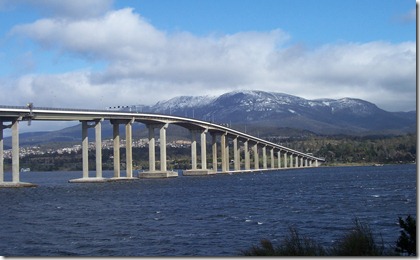
I took this photo on Friday 17/09/2010. As you may have gathered I love taking photos of iconic views around Hobart. Although a little history couldn’t go astray so…: Tasman Bridge: construction first began in May 1960 and was first completed on December 23rd 1964. Its width is 17.5 meters (from rail to rail), stands 60.5 meters high at it’s apex and is 1,395 meters long. The A3 Tasman Highway runs across it. Disaster, January 5th, 1975. An almighty bang! I actually woke up to this as I was living in Lindisfarne at the time, at approximately 9.27pm the bridge was struck by a bulk ore carrier, The Illawarra, coming up the Derwent to the local Zinc works carrying a load of around 10,000 tons of zinc concentrate. The ship hit the two central pylons collapsing them and causing the 3 main concrete decking sections to fall onto the bridge causing it to sink, lives were lost, both on board the ship and cars that were crossing the bridge at that time. The ship is still there today, the bridge has actually been rebuilt over the top of the carrier and if you venture to Hobart I suggest that you visit our museum as they have a model of the ship with the bridge construction over it.
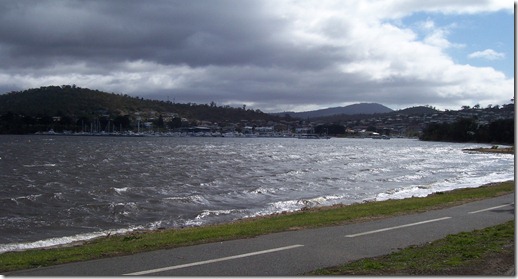
Lindisfarne bay, I grew up around this area
Reference: http://en.wikipedia.org/wiki/Tasman_Bridge
Saturday, September 18, 2010
WEB 101 WEEK 3 MODULE 2 – INTRODUCTION – WHAT IS WEB 2.0
Web 101 Week 3 Module 2
Introduction Web 2.0
Instructions
Work through the guiding text below, viewing the videos and/or clicking on the highlighted links for further information as you need it. External students should complete any activities as you come across them (Internal students will be completing these activities in the workshop). (Curtin University Topic information 2010 SP3)
I began the module by watching a 4 minute YouTube video What Is Web 2.0 Design Patterns and Business Models for the Next Generation of Software 09/30/2005Web 2.0 The machine is Us/ing Us. It discusses how digital text is different in comparison to html. "Form and content can be separated, and you don't need to understand complicated codes to be able to upload to web pages Everything has layers, that WE are teaching the machines, WE are the web. 100 billion people click on the web each day. Web 2.0 is linking people......." (text exerts from Web 2.0 The machine is Us/ing Us)"There is only one time in the history of each planet when its inhabitants first wire up its innumerable parts to make one large Machine. Later that Machine may run faster, but there is only one time when it is born. You and I are alive at this moment." (Kelly, 2005) (Curtin University Information notes Web 101, 2010 SP 3)
I progressed on to reading the article by Kevin Kelly
And updated Oct. 2009: Tim O'Reilly and John Battelle answer the question of "What's next for Web 2.0?" in The Wisdom of the Chaperones Slate Magazine on line article. Chris Wilson, author of the article, rather cynically talks about how it is becoming harder for him to hate Wikipedia. He delves into how Wikipedia is becoming a "force for good."(Wilson 2008) That it appears that only 1percent (Chi and Palo Alto Research Center, Incorporated, Tues 5th May 2007) of users are responsible for half the Wikipedia edits. He also discusses how social media sites e.g. Facebook and Digg, have become peer leaders in "web democracy" (page1) and build by the masses for the masses. I was interested to note that Digg, like Wikipedia also had a small number of contributors, 100, uploading nearly half, 44%, the sites information. (Saleem, 19 July 2007)Web Squared: Web 2.0 Five Years On. Tim O'Reilly discusses in the article the subsequent changes and conception of Web 2.0, that have happened to the World Wide Web since 2001. He utilises this article to clarify what Web 2.0 is.
O'Reilly suggests that there is a contrast point where the platform for Web 1.0 and Web 2.0 diverge, Netscape Vs Google and "In the end, both web browsers and web servers turned out to be commodities." (O'Reilly 2009) and goes on to suggest that Google isn't just software but a database that requires specialised tools.
Reading #1
'We are the Web'. "The Netscape IPO wasn't really about dot-commerce. At its heart was a new cultural force based on mass collaboration. Blogs, Wikipedia, open source, peer-to-peer - behold the power of the people" (Wired on-line magazine. Issue 13.08 - August 2005) It is an account of Kevin Kelly's personal meeting with Ted Nelson in 1984, Kelly's involvement with Wired magazine, the evolution of hypertext/links and the progression of Netscape over the period of a decade. An easy and informative/informed article to read.
| Web 1.0 | Web 2.0 | |
| DoubleClick | --> | Google AdSense |
| Ofoto | --> | Flickr |
| Akamai | --> | BitTorrent |
| mp3.com | --> | Napster |
| Britannica Online | --> | Wikipedia |
| personal websites | --> | blogging |
| evite | --> | upcoming.org and EVDB |
| domain name speculation | --> | search engine optimization |
| page views | --> | cost per click |
| screen scraping | --> | web services |
| publishing | --> | participation |
| content management systems | --> | wikis |
| directories (taxonomy) | --> | tagging ("folksonomy") |
| stickiness | --> | syndication |
Graphic 1.
Reading #3
WEB 2.0 – BEYOND THE BUZZWORD
Web 1.0 is a term that has been coined after Web 2.0 came into use. The Curtin Information Web 101 Module 2 uses the term retronym. Now retronym according to Wikipedia is: "Retronym (Mankiewicz, 1980) is a new name for an object or concept to differentiate the original form or version of it from a more recent form or version. The original name is most often augmented with an adjective (rather than being completely displaced) to account for later developments of the object or concept itself. Much retronymy is driven by advances in technology."
Web 1.0 is the web system that was utilised prior to 2003 and had static pages with content that was designed for dial up modem (52kbps), web page designers utilised html language and you virtually had to be a 'geek' (Wikipedia) to build a page.
Web 2.0 is a term that is utilised to categorise the changes in internet technology, people's use of the World Wide Web and the development of the web since 2003. (basically new ways of developing web sites – e.g. Google maps, where you don't have to reload the page to get new data, it's done asynchronously in the back ground, majority of web 2.0 is user-driven content (rich).
Cloud computing (fig.2.) (Wikipedia) is Internet-based computing, whereby shared resources, software, and information are provided to computers and other devices on demand, like the electricity grid.
Here Comes Everybody – Web 2.0 expo 2008: (embedded Curtin Lecture) A media lecture by Clay Shirky : Web 2.0 Lecture
All I can say is I what an excellent lecture. He discussed his experience with a media reporter and how she didn't quite grasp the revolution/transformation that the WWW has had on today's society. He talks also about the industrial revolution and how it has affected society in that the working man was working a 5 day week and experiencing 'free time', drank a lot of gin, wasted a lot of time. He then progressed through to his child hood experiences watching Gilligan's Island.
Meta data: data about data e.g. movie, when it was made, where it was made, the writer, the producer, syndication, actors, actors bio's etc film style, how it was filmed (you get the picture)
Dynamic content. The separation of form and content. Modern websites are able to separate the descriptive form from the actual content.
ACTIVITY ONE – NEWS FLASH
RSS - (REALLY SIMPLE SYNDICATION)
We were asked to open up a page.
News.com.au http://www.news.com.au/ and look at:
2:32pmMum still washes dead son's clothes
And then look at the news feed that was running underneath. (breaking news RSS feed powered by Google) At the time the feed correlated with the headlines (above). The RSS feed was imbedded in the information page that was supplied by Curtin. I right clicked next to the "breaking news" and viewed the source code.</ul>
<table width="750" border="0" cellpadding="20">
<tr>
<td><!-- ++Begin Dynamic Feed Wizard Generated Code++ -->
<!--
// Created with a Google AJAX Search and Feed Wizard
// http://code.google.com/apis/ajaxsearch/wizards.html
-->
<!--
// The Following div element will end up holding the actual feed control.
// You can place this anywhere on your page.
-->
<div id="feed-control">
<span style="color:#676767;font-size:11px;margin:10px;padding:4px;">Loading...</span>
</div>
<!-- Google Ajax Api
-->
<script src="http://www.google.com/jsapi?key=notsupplied-wizard"
type="text/javascript"></script>
<!-- Dynamic Feed Control and Stylesheet -->
<script src="http://www.google.com/uds/solutions/dynamicfeed/gfdynamicfeedcontrol.js"
type="text/javascript"></script>
<style type="text/css">
@import url("http://www.google.com/uds/solutions/dynamicfeed/gfdynamicfeedcontrol.css");
</style>
<script type="text/javascript">
function LoadDynamicFeedControl() {
var feeds = [
{title: 'Breaking News',
url: 'http://feeds.news.com.au/public/rss/2.0/news_breaking_news_32.xml'
}];
var options = {
stacked : false,
horizontal : true,
title : ""
}
new GFdynamicFeedControl(feeds, 'feed-control', options);
}
// Load the feeds API and set the onload callback.
google.load('feeds', '1');
google.setOnLoadCallback(LoadDynamicFeedControl);
</script>
<!-- ++End Dynamic Feed Control Wizard Generated Code++ -->
Standards
I read about how all available technologies work together.
Ajax
JavaScript and XML (Wikipedia, 14 September 2010 at 06:00.)
XHTML Extensible Hypertext Markup Language
CSS Cascading style sheet
JavaScript is an implementation of the ECMA script language standard and is typically used to enable programmatic access to computational objects within a host environment ( I need to learn more about this. Javascript is everywhere. And it includes the following, and then some)
ECMA The language is widely used for client side script on the web, in the form of several well-known dialects such as JavaScript. The interactive list goes on.
Scalability interesting designers needed to ensure that they consider initial development of their application.
The Business Perspective Tim O'Reilly's definition of Web 2.0: "the business revolution in the computer industry caused by the move to the internet as platform, and an attempt to understand the rules for success on that new platform. Chief among those rules is this: Build applications that harness network effects to get better the more people use them." (Curtin University Course information 2010)
ACTIVITY TWO – CREATING A DELICIOUS ACCOUNT.
We were asked to do the following:
Go to the http://www.youtube.com/watch?v=3NN3uej7IMs&feature=player_embedded delicious website here (WENT TO THE DELICIOUS WEBSITE)
Now, sign up to use the service. (Ideally using the username you selected at the beginning of the unit)(YES, DID THAT A COUPLE OF WEEKS AGO. USER NAME loulounilly,/Laura Herbert's book marks)
Once you've done that, go to delicious' tools page and add a bookmarking button to your browser.(I HAD TO SAVE TO MY FAVORITES AS INTERNET EXPLORER WOULDNT DOWNLOAD THE BUTTON)
You are now ready to start using delicious.(ITS A VERY HANDY TOOL)
Over the course of the next week, try doing a little web searching for articles related to Web 2.0 and 'social media'. Whenever you find a site that you think might be useful (to both yourself and other students), bookmark that site and tag it web101 and write a short annotation detailing what the resource is and why it is useful.
Of course, you can apply any other tags that are meaningful to you, but make sure to use this shared tag as well as those of your own.
Through the week, try to gather at least 5 sites in this way.
At the end of the week, use the tag search in delicious to search for sites with the tag web101 to see the sites that your fellow students have bookmarked. (Curtin, 2010)
Watched YouTube : Andrew McAfee on Enterprise 1 hour, 12 minutes and 15 seconds.
References
The machine is Us/ing Us:
YouTube via Curtin Unit Web 101 unit information.
Kevin Kelly (August 2005) . We Are the Web: Wired on-line magazine
Issue 13.8
Tim O'Reilly, John Battelle (Oct. 2009):
What is Web 2.0 Design Patterns and Business Models for the Next Generation of Software 09/30/2005
Tim O'Reilly and John Battelle answer the question of "What's next for Web 2.0?" in Web Squared: Web 2.0 Five Years On.
Graphic 1 http://oreilly.com/web2/archive/what-is-web-20.html
Author Chris Wilson (Friday 22, 2008), The Wisdom of the Chaperones, Technology: THE FUTURE AND WHAT TO DO ABOUT IT. Slate on line Magazine
The Augmented Social Cognition Research Group at Palo Alto Research Centre (PARC).
(Chi and Palo Alto Research Center)
2003-2004," administrators in Wikipedia was making around 50% of edits! Definitely seemed like "power of the few" was at work in Wikipedia. Indeed, admins in Wikipedia have a great deal of power. They set policies, ban destructive users, help resolve disputes, and generally keep order within the system."
Author: Muhammad Saleem. Pronet Advertising. The power of Digg Top Users (one year later)
19th July 2007
Retronym coined by Frank Mankiewicz in 1980
Geek : a person interested in technology, especially computing and new media.
Subscribe to:
Posts (Atom)




